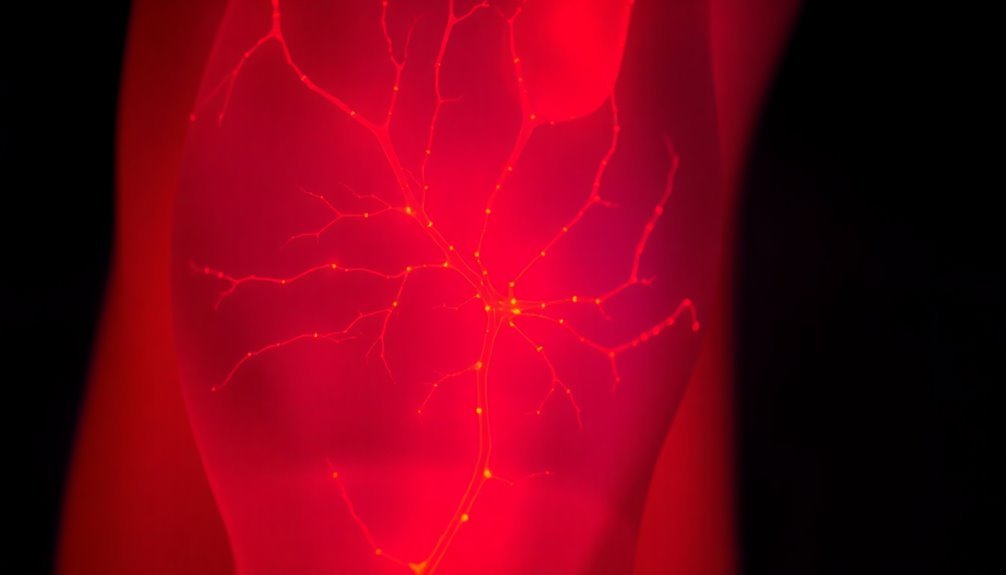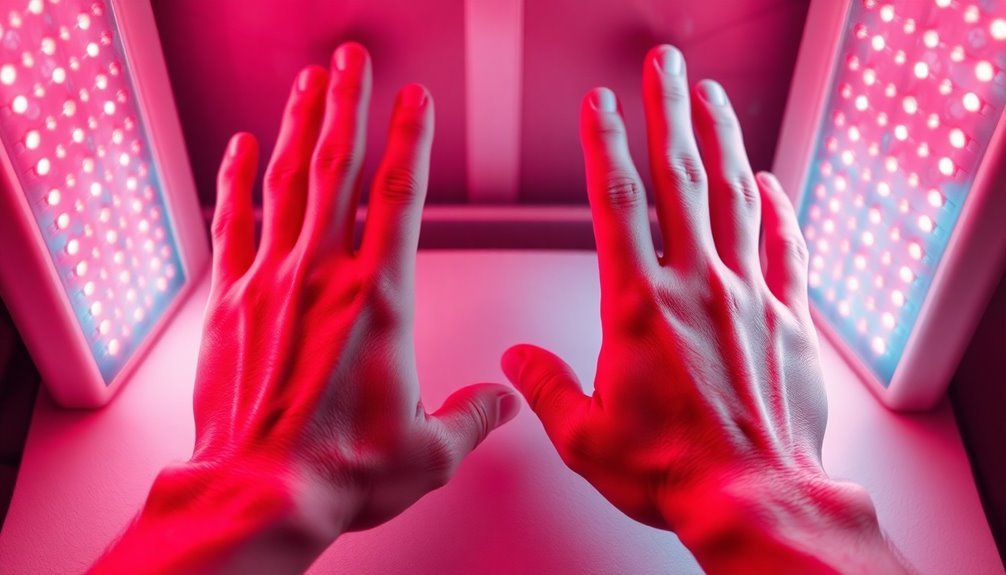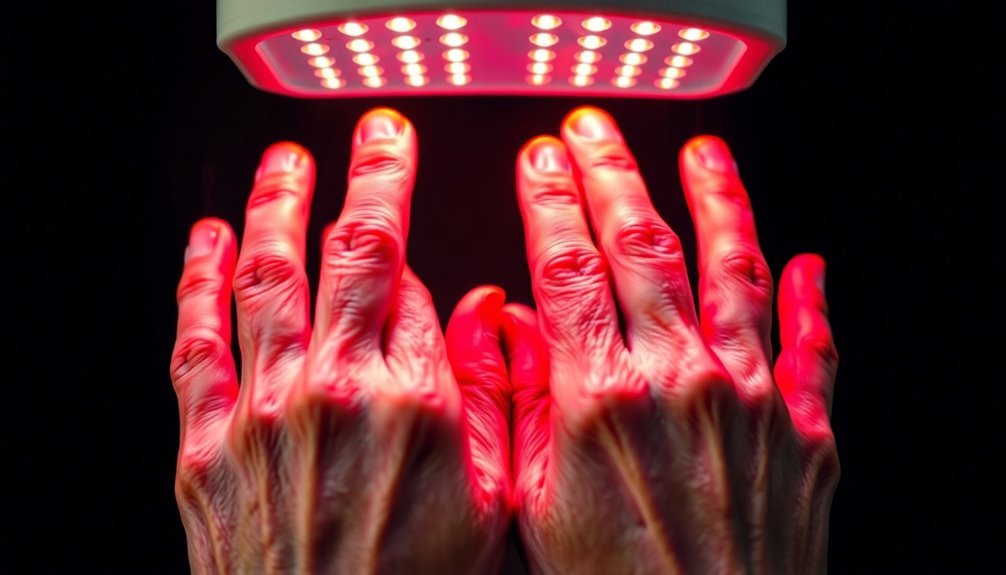Light therapy reduces joint swelling in three powerful ways. First, it stimulates your blood vessels to widen and relax, improving circulation to deliver healing nutrients while removing inflammatory waste products. Second, it kickstarts your body's cellular repair mechanisms, boosting ATP production and triggering tissue regeneration at the molecular level. Third, it directly modulates your inflammatory response by targeting key molecules like TNF-α and IL-6, effectively controlling inflammation at its source. These natural healing processes work together to decrease swelling and improve your joint mobility, and understanding their full impact can transform your approach to joint health.
Blood Flow and Circulation

Light therapy's impact on blood flow and circulation stands out as a key factor in treating joint swelling. When you undergo light therapy treatment, it stimulates the production of nitric oxide in your body, which naturally relaxes and widens your blood vessels.
This process enhances blood circulation throughout the affected areas, delivering essential nutrients and oxygen to your joints while removing harmful waste products. The therapy utilizes deep red LED lights at specific wavelengths to ensure optimal penetration into the joint tissue.
You'll benefit from the therapy's ability to promote endothelial cell growth, which helps form new capillaries and strengthens existing ones. As your circulation improves, anti-inflammatory proteins travel more efficiently through your bloodstream, directly targeting areas of inflammation and swelling.
The increased blood flow doesn't just reduce inflammation – it actively supports tissue repair and regeneration in your joints.
The process works systematically: enhanced blood flow leads to better oxygenation of your joint tissues, which in turn promotes healing and reduces stiffness. If you're dealing with persistent joint swelling, light therapy's ability to improve circulation can make a significant difference in your mobility and comfort level, as it addresses both the symptoms and underlying causes of joint inflammation.
Cellular Repair Mechanisms
While improved circulation sets the stage for healing, the real power of light therapy lies in its profound effects at the cellular level. When you undergo light therapy, it triggers several critical repair mechanisms within your cells, starting with enhanced mitochondrial function.
Your cells' powerhouses begin producing more ATP, providing the energy needed for healing and regeneration.
You'll benefit from increased cellular proliferation as the therapy stimulates tissue regeneration. It's particularly effective at boosting collagen production, which helps repair and strengthen the connective tissues around your joints.
The therapy also protects your cells by reducing oxidative stress and preventing cellular damage that often contributes to joint problems. Nitric oxide release during treatment helps widen blood vessels and increase healing blood flow to affected areas.
What's more, light therapy optimizes your body's natural healing processes through sophisticated cellular signaling. It modulates inflammation by influencing macrophage behavior, helping your body shift from the inflammatory phase to the regeneration phase more efficiently.
The therapy works directly on affected areas, triggering repair mechanisms from deep within your tissues. This cellular-level approach means you're not just masking symptoms – you're addressing the root causes of joint swelling through natural healing processes.
Inflammatory Response Modulation

Through a sophisticated biological cascade, light therapy powerfully modulates your body's inflammatory response to joint swelling. The therapy directly targets key inflammatory molecules like TNF-α, IL-6, and IL-8, substantially reducing their levels in your affected joints. This reduction helps calm overactive immune responses that contribute to swelling and discomfort. The therapy also helps prevent Langerhans cell migration into affected tissues, which further reduces inflammatory responses.
When you receive light therapy, it activates important cellular pathways, particularly the Nrf2 pathway, which strengthens your body's natural antioxidant defenses. The treatment also modulates the NF-kB pathway, helping to control inflammation at its source.
You'll experience reduced infiltration of inflammatory cells to your joint areas, while beneficial anti-inflammatory compounds increase.
The therapy's effects extend beyond direct inflammation control. As you undergo treatment, you'll benefit from enhanced blood flow and oxygen delivery to your affected joints. This improved circulation helps remove inflammatory substances while delivering healing nutrients.
The light energy also boosts your cells' energy production through increased ATP, which accelerates tissue repair and further reduces swelling. Clinical studies consistently show that this multi-faceted approach effectively reduces joint inflammation and associated pain.
Frequently Asked Questions
How Long Does Each Light Therapy Session Typically Last?
Your light therapy sessions will typically last between 3-20 minutes. You'll usually start with 5-10 minutes as a beginner, and you can gradually increase to 15-20 minutes as you become more accustomed.
Can Light Therapy Be Used Alongside Other Arthritis Treatments?
Yes, you can safely combine light therapy with other arthritis treatments. It's a non-invasive option that works well alongside medications, physical therapy, and other interventions to enhance your overall pain management and treatment outcomes.
What's the Average Cost of a Professional Light Therapy Device?
Based on the market data, you'll find professional light therapy devices typically cost between $2,300 and $48,000, with most mid-range options falling around $15,000. The price depends on features and technology sophistication.
Is Light Therapy Covered by Health Insurance Plans?
Your insurance coverage for light therapy varies by provider and plan. You'll need to check with your specific insurer, as some plans cover it for certain conditions while others don't offer coverage at all.
How Soon After Surgery Can Someone Start Light Therapy Treatments?
You can start light therapy treatments immediately after surgery with your doctor's approval. It's important to get clearance from your surgeon first, as they'll consider your specific procedure and recovery needs.
In Summary
You've learned how light therapy targets joint swelling through multiple pathways. It's boosting your circulation to deliver healing nutrients, activating your body's natural repair processes at the cellular level, and helping to regulate your inflammatory responses. By understanding these mechanisms, you can make informed decisions about incorporating light therapy into your joint health routine and work with your healthcare provider to develop an effective treatment plan.





Leave a Reply